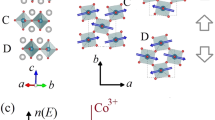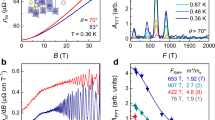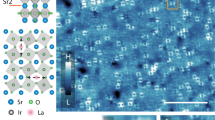Abstract
The Ruddlesden–Popper series of iridates (Srn+1IrnO3n+1) have been the subject of much recent attention due to the anticipation of emergent phenomena arising from the cooperative action of spin–orbit-driven band splitting and Coulomb interactions1,2,3. However, an ongoing debate over the role of correlations in the formation of the charge gap and a lack of understanding of the effects of doping on the low-energy electronic structure have hindered experimental progress in realizing many of the predicted states4,5,6,7,8,9. Using scanning tunnelling spectroscopy we map out the spatially resolved density of states in Sr3Ir2O7 (Ir327). We show that its parent compound, argued to exist only as a weakly correlated band insulator, in fact possesses a substantial ~ 130 meV charge excitation gap driven by an interplay between structure, spin–orbit coupling and correlations. We find that single-atom defects are associated with a strong electronic inhomogeneity, creating an important distinction between the intrinsic and spatially averaged electronic structure. Combined with first-principles calculations, our measurements reveal how defects at specific atomic sites transfer spectral weight from higher energies to the gap energies, providing a possible route to obtaining metallic electronic states from the parent insulating states in the iridates.
This is a preview of subscription content, access via your institution
Access options
Subscribe to this journal
Receive 12 print issues and online access
$259.00 per year
only $21.58 per issue
Buy this article
- Purchase on Springer Link
- Instant access to full article PDF
Prices may be subject to local taxes which are calculated during checkout





Similar content being viewed by others
References
Kim, B. J. et al. Novel Jeff = 1/2 Mott state induced by relativistic spin–orbit coupling in Sr2IrO4 . Phys. Rev. Lett. 101, 076402–076405 (2008).
Kim, B. J. et al. Phase-sensitive observation of a spin–orbital Mott state in Sr2IrO4 . Science 323, 1329–1332 (2009).
Moon, S. J. et al. Dimensionality-controlled insulator-metal transition and correlated metallic state in 5d transition metal oxides Srn+1IrnO3n+1 (n = 1, 2, and ). Phys. Rev. Lett. 101, 226402–226405 (2008).
Jackeli, G. & Khaliullin, G. Mott insulators in the strong spin–orbit coupling limit: From Heisenberg to a quantum compass and Kitaev models. Phys. Rev. Lett. 102, 017205–017208 (2009).
Shitade, A. et al. Quantum spin Hall effect in a transition metal oxide Na2IrO3 . Phys. Rev. Lett. 102, 256403–256406 (2009).
Wan, X. et al. Topological semimetal and Fermi-arc surface states in the electronic structure of pyrochlore iridates. Phys. Rev. B 83, 205101–205109 (2011).
Wang, F. & Senthil, T. Twisted Hubbard model for Sr2IrO4: Magnetism and possible high temperature superconductivity. Phys. Rev. Lett. 106, 136402–136405 (2011).
Pesin, D. & Balents, L. Mott physics and band topology in materials with strong spin–orbit interaction. Nature Phys. 6, 376–381 (2010).
Carter, J. M., Shankar, V. V. & Kee, H. Y. Theory of magnetic structure in layered iridates: Spin–orbit band or Mott insulators. Preprint at http://arxiv.org/abs/1207.2183 (2012).
Kane, C. L. & Mele, E. J. Z2 topological order and the quantum spin Hall effect. Phys. Rev. Lett. 95, 146802–146805 (2005).
Hasan, M. Z. & Kane, C. L. Topological insulators. Rev. Mod. Phys. 82, 3045–3067 (2010).
Nagaosa, N. & Tokura, Y. Emergent electromagnetism in solids. Phys. Scr. T146, 014020–014035 (2012).
Mühlbauer, S. et al. Skyrmion lattice in a chiral magnet. Science 323, 915–919 (2009).
Imada, M., Tokura, Y. & Fujimori, A. Metal–insulator transition. Rev. Mod. Phys. 70, 1039–1263 (1998).
Hsieh, D. et al. Observation of a metal-to-insulator transition with both Mott–Hubbard and Slater characteristics in Sr2IrO4 from time-resolved photocarrier dynamics. Phys. Rev. B 86, 035128 (2012).
Fujiyama, S. et al. Weak antiferromagnetism of Jeff = 1/2 band in bilayer iridate Sr3Ir2O7 . Phys. Rev. B 86, 174414 (2012).
Arita, R. et al. Ab initio studies on the interplay between spin–orbit interaction and coulomb correlation in Sr2IrO4 and Ba2IrO4 . Phys. Rev. Lett. 108, 086403–086406 (2012).
Cao, G. et al. Anomalous magnetic and transport behavior in the magnetic insulator Sr3Ir2O7 . Phys. Rev. B 66, 214412–214418 (2002).
Dhital, C. et al. Spin ordering and electronic texture in the bilayer iridate Sr3Ir2O7 . Phys. Rev. B 86, 100401–100404 (2012).
Wang, Q. et al. Dimensionality controlled Mott transition and correlation effects in single- and bi-layer perovskite iridates. Preprint at http://arxiv.org/abs/1210.4141 (2012).
Wojek, B. M. et al. The Jeff = 1/2 Mott insulator Sr3Ir2O7 studied by angle-resolved photoemission spectroscopy. J. Phys.: Condens. Matter 24, 415602 (2012).
Dagotto, E. Complexity in strongly correlated electronic systems. Science 309, 257–262 (2005).
Pan, S. H. et al. Microscopic electronic inhomogeneity in the high- Tc superconductor Bi2Sr2CaCu2O8+x . Nature 413, 282–285 (2001).
Lee, J. et al. Heavy d-electron quasiparticle interference and real-space electronic structure of Sr3Ru2O7 . Nature Phys. 5, 800–804 (2009).
Iwaya, K. et al. Local tunneling spectroscopy across a metamagnetic critical point in the bi-layer ruthenate Sr3Ru2O7 . Phys. Rev. Lett. 99, 057208–057211 (2007).
Subramanian, M. A., Crawford, M. K. & Harlow, R. L. Single crystal structure determination of double layered strontium iridium oxide Sr3Ir2O7 . Mater. Res. Bull. 29, 645–650 (1994).
Korneta, O. B. et al. Electron-doped Sr2IrO4−δ (0≤δ≤0.04): Evolution of a disordered Jeff = 1/2 Mott insulator into an exotic metallic state. Phys. Rev. B 82, 115117 (2010).
Tokura, Y., Takagi, H. & Uchida, S. A superconducting copper oxide compound with electrons as the charge carriers. Nature 337, 345–347 (1989).
Ohta, Y., Tohyama, T. & Maekawa, S. Apex oxygen and critical temperature in copper oxide superconductors: Universal correlation with the stability of local singlets. Phys. Rev. B 43, 2968–2982 (1991).
Pavarini, E. et al. Band-structure trend in hole-doped cuprates and correlation with Tcmax . Phys. Rev. Lett. 87, 047003–047006 (2001).
Kohsaka, Y. et al. Visualization of the emergence of the pseudogap state and the evolution to superconductivity in a lightly hole-doped Mott insulator. Nature Phys. 8, 534–538 (2012).
Ye, C. et al. Visualizing the atomic scale electronic structure of the Ca2CuO2Cl2 Mott insulator. Nature Commun. 4, 1365 (2013).
Zhou, S. et al. Electron correlation and Fermi surface topology of NaxCoO2 . Phys. Rev. Lett. 94, 206401–206404 (2005).
Acknowledgements
V.M. gratefully acknowledges funding from US NSF-CAREER-0645299 for support of D.W., Y.O. and W.Z. S.D.W. acknowledges NSF DMR-1056625 for support of C.D. and S.K. Z.W. acknowledges the DOE grants: DE-FG02-99ER45747 and DOE DE-SC0002554. T.R.C. and H.T.J. are supported by the National Science Council, Taiwan. H.T.J also thanks NCHC, CINC-NTU and NCTS, Taiwan for technical support. The work at Northeastern University is supported by the US Department of Energy, Office of Science, Basic Energy Sciences contract DE-FG02-07ER46352, and benefited from Northeastern University’s Advanced Scientific Computation Center (ASCC), theory support at the Advanced Light Source, Berkeley and the allocation of supercomputer time at NERSC through DOE grant number DE-AC02-05CH11231.
Author information
Authors and Affiliations
Contributions
Y.O. and V.M. designed the experiments. Y.O., M.P., W.Z. and D.W. participated in the the experiments. V.M., Y.O., S.D.W., Z.W. and D.W. wrote the paper. C.D. and S.K. made single-crystal samples. Z.W., H-T.J., T-R.C., H.L. and A.B. carried out the theoretical calculations.
Corresponding author
Ethics declarations
Competing interests
The authors declare no competing financial interests.
Supplementary information
Supplementary Information
Supplementary Information (PDF 1628 kb)
Rights and permissions
About this article
Cite this article
Okada, Y., Walkup, D., Lin, H. et al. Imaging the evolution of metallic states in a correlated iridate. Nature Mater 12, 707–713 (2013). https://doi.org/10.1038/nmat3653
Received:
Accepted:
Published:
Issue Date:
DOI: https://doi.org/10.1038/nmat3653
This article is cited by
-
Evidence for a spinon Kondo effect in cobalt atoms on single-layer 1T-TaSe2
Nature Physics (2022)
-
Antiferromagnetic excitonic insulator state in Sr3Ir2O7
Nature Communications (2022)
-
Evidence for one-dimensional chiral edge states in a magnetic Weyl semimetal Co3Sn2S2
Nature Communications (2021)
-
Doping induced Mott collapse and possible density wave instabilities in (Sr1−xLax)3Ir2O7
npj Quantum Materials (2019)
-
Universality of pseudogap and emergent order in lightly doped Mott insulators
Nature Physics (2017)



